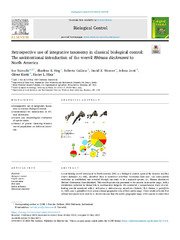Приказ основних података о документу
Retrospective use of integrative taxonomy in classical biological control: The unintentional introduction of the weevil Rhinusa dieckmanni to North America
| dc.creator | Tosevski, Ivo | |
| dc.creator | Sing, Sharlene | |
| dc.creator | Caldara, Roberto | |
| dc.creator | Weaver, David | |
| dc.creator | Jovic, Jelena | |
| dc.creator | Krstić, Oliver | |
| dc.creator | Hinz, Hariet | |
| dc.date.accessioned | 2023-07-14T08:53:08Z | |
| dc.date.available | 2023-07-14T08:53:08Z | |
| dc.date.issued | 2023 | |
| dc.identifier.issn | 1049-9644 | |
| dc.identifier.uri | https://plantarum.izbis.bg.ac.rs/handle/123456789/709 | |
| dc.description.abstract | A seed-feeding weevil introduced to North America (NA) as a biological control agent of the invasive toadflax Linaria dalmatica (L.) Mill., identified then as Gymnetron antirrhini “Dalmatian host race” and subsequently confirmed as established, was revealed through our study to be a separate species, i.e., Rhinusa dieckmanni (Behne) (Coleoptera: Curculionidae). This weevil species was presumed to be endemic in its native range, with a distribution restricted to Mount Rila in southwestern Bulgaria. We conducted a comprehensive study of seed-feeding weevils associated with L. dalmatica, L. dalmatica ssp. macedonica (Griseb.) D.A. Sutton, L. genistifolia (L.) Mill., and L. grandiflora Desf. across a broad geographic area of their native range. Those results revealed that all four host plants were used by R. dieckmanni and thus the native geographic range of the species is wider than expected, encompassing the Balkans and the Anatolian Plateau. Our observations suggest that phenotypes of this weevil are highly variable and dependent on the seed capsule size of the Linaria host population. The haplotype network based on mitochondrial COII, 16S genes, and nuclear EF 1-α gene genealogy confirmed the conspecific nature of geographically distant weevil populations, that is, R. dieckmanni phenotypes utilizing L. genistifolia, L. dalmatica, and L. grandiflora for larval development. Specimens collected from L. dalmatica in the northwestern USA shared the same haplotypes as samples from L. dalmatica ssp. macedonica in southwestern North Macedonia, supporting the known introduction history of the North American population. Females from these populations have relatively short rostrums, which may limit their reproductive success on North American invasive L. dalmatica with larger seed capsules. | sr |
| dc.language.iso | en | sr |
| dc.publisher | Elsevier | sr |
| dc.relation | info:eu-repo/grantAgreement/MESTD/inst-2020/200010/RS// | sr |
| dc.relation | USDA Forest Service Rocky Mountain Research Station and FHTET-BC BCIP grant program | sr |
| dc.relation | USDI Bureau of Land Management, Montana State University, and the Montana Noxious Weed Trust Fund | sr |
| dc.rights | openAccess | sr |
| dc.rights.uri | https://creativecommons.org/licenses/by/4.0/ | |
| dc.source | Biological Control | sr |
| dc.subject | Biological control | sr |
| dc.subject | Cryptic species | sr |
| dc.subject | Curculionidae | sr |
| dc.subject | Host races | sr |
| dc.subject | Linaria dalmatica | sr |
| dc.subject | Phenotypic plasticity | sr |
| dc.title | Retrospective use of integrative taxonomy in classical biological control: The unintentional introduction of the weevil Rhinusa dieckmanni to North America | sr |
| dc.type | article | sr |
| dc.rights.license | BY | sr |
| dc.citation.rank | aM21~ | |
| dc.citation.volume | 183 | |
| dc.type.version | publishedVersion | sr |
| dc.identifier.doi | 10.1016/j.biocontrol.2023.105270 | |
| dc.identifier.fulltext | http://plantarum.izbis.bg.ac.rs/bitstream/id/2891/bitstream_2891.pdf | |
| dc.identifier.scopus | 2-s2.0-85160568571 |


